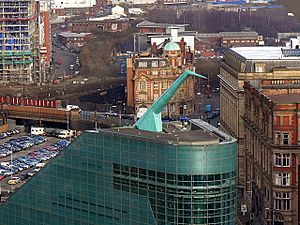Urbis facts for kids
Quick facts for kids Urbis |
|
|---|---|
|
National Football Museum
|
|

Urbis from Corporation Street
|
|
| General information | |
| Status | Home of National Football Museum (since 2012) |
| Type | Exhibition and Museum Centre |
| Location | Cathedral Gardens, Manchester city centre, Manchester |
| Opened | 2002 |
| Cost | £30 million |
| Technical details | |
| Structural system | Concrete and glass |
| Floor count | 6 |
| Design and construction | |
| Architect | Ian Simpson |
| Architecture firm | SimpsonHaugh and Partners |
Urbis is a cool building in Manchester, England. It was designed by Ian Simpson and opened in 2002. At first, it was a museum about city life. Later, it changed to show exhibitions about popular culture. In 2012, Urbis became the new home for the National Football Museum.
Contents
Building Design and Features
Urbis is located in Cathedral Gardens. It was designed by the company SimpsonHaugh and Partners. The building has six floors and a unique sloped shape. Visitors can take a lift to the top floor to see amazing views of the city. Then, they walk down through different levels, called mezzanine floors, to see the exhibits.
The outside of Urbis is made of about 2,200 glass panels. These panels are arranged in long, horizontal strips. The building also has smart systems to save energy. It uses a special cooling system for summer and a heat recovery system for winter. This makes it very energy efficient!
Urbis's Story: From City Museum to Football Fun
Urbis first opened on June 27, 2002. It was meant to be a museum showing what inner-city life was like. The building was a symbol of new beginnings for Manchester after a big bomb attack in 1996. The project received a lot of money, about £30 million, to help it get started.
At first, Urbis struggled to attract visitors. Many people found the exhibits a bit confusing. The museum's first director even left in 2003. Visitor numbers were much lower than expected. There was a worry that the museum might have to close.
To fix this, a big change happened in December 2003: the £5 admission fee was removed! This made a huge difference. Visitor numbers quickly grew, becoming five times higher than before.
In 2004, Urbis decided to focus on British popular culture, especially things from Manchester. It stopped calling itself a "museum" and became an exhibition centre. With free entry, more people came, and Urbis became a popular spot.
The National Football Museum Moves In
In February 2010, Urbis closed its doors for another big change. It was going to become the new home for the National Football Museum. This museum had been in Preston, Lancashire, but needed a new location. Moving to Manchester meant more people could visit, with an expected 400,000 visitors each year.
There was some disagreement about the move. Preston City Council wanted the museum to stay. However, Manchester City Council offered more money to help the museum relocate. The National Football Museum opened in Urbis in 2012. It offers free admission, just like Urbis did before. In its first nine months, the museum welcomed 350,000 visitors!
Past Exhibitions and Events
Urbis has hosted many interesting exhibitions over the years. Here are a few examples:
- 2009
- State of Art: New York showed modern art from New York City.
- Videogame Nation explored how video games grew into a huge industry.
- Home Grown: The Story of UK Hip Hop looked at the history of hip-hop music in the UK.
- 2008
- How Manga Took Over The World explored how Japanese comics influenced art.
- Urban Gardening showed ideas for gardening in city areas.
- 2007
- The Haçienda 25 The Exhibition celebrated a famous Manchester music club.
- PLAY: Experience the Adventure of Our Cities was about exploring cities.
- 2006
- British Art Show 6 featured new art from across Britain.
- Little Black Dress explored the history of this classic fashion item.
- 2005
- Rock 'n' Roll Icons showed photos by Mick Rock.
- Punk: ... Seditionaries and the Sex Pistols looked at the punk music movement.
- SuperCity explored ideas about future cities.
- 2004
- Manchester 24 was about life in Manchester.
- The Peter Saville Show featured the work of a famous designer.
- 2003
- Compost Cities explored eco-friendly city ideas.
- Taxi! was an exhibition all about taxis.
- 2002
- Architecture by Stealth was one of the first exhibitions.
Fun Facts About Urbis
- The name "Urbis" means "city" in Latin.
- The building has won several awards for its amazing design.
- Urbis is a popular spot for taking photos. This is because of its unique shape and glass walls.
- The National Football Museum has over 140,000 items in its collection!
See also
- Cathedral Gardens






